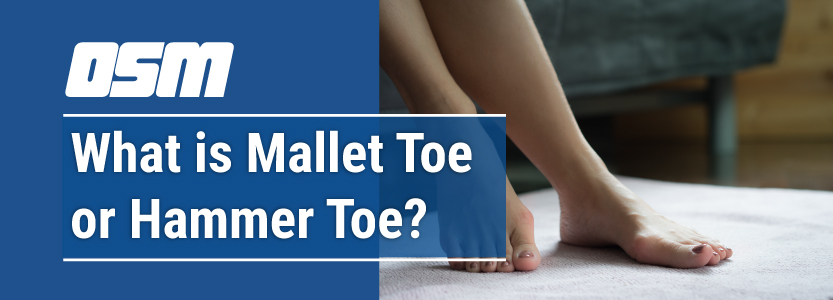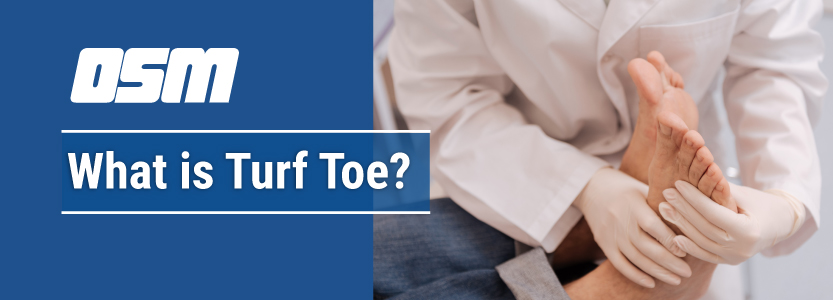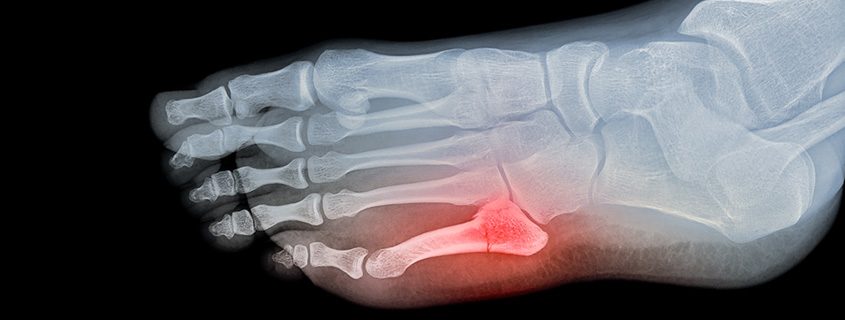What is Mallet Toe or Hammer Toe?
Article featured on Mercy Health
What is hammer toe or mallet toe?
Hammer toe is a foot abnormality that occurs because of imbalanced muscles, tendons, or ligaments around the toe. It typically impacts the second, third, or fourth toes. The toe appears like a hammer because it is bent in the middle joint of the toe.
Hammer toe can be healed with relatively simple treatments, but if left untreated may require surgery. Many people with hammer toe develop corns or calluses on the top of the middle joint of the toe or on the tip of the toe.
A mallet toe is like hammer toe but impacts the joint closest to the tip of the toe.
Causes of hammer toe or mallet toe
There are many causes of hammer or mallet toe including:
- Shoes that do not fit properly such as high-heeled shoes that do not have a proper toe box.
- An impact such as jamming and breaking the toe can cause hammer toe or mallet toe.
- Imbalanced toe muscles can cause toes to contract.
Risk factors for hammer toe or mallet toe
- Age — hammer toe or mallet toe affect older people more than younger people but all ages can develop the conditions.
- Gender — women are more likely to develop hammer or mallet toe.
- Heredity — hammer toe or mallet toe can be passed down from parents.
- Second toe length — a person who has a long second toe (longer than the big toe) is more likely to develop hammer or mallet toe.
Symptoms of hammer toe or mallet toe
Symptoms of hammer toe or mallet toe include:
- Bend in the joint of the toe that is not typical
- Pain when bending the toe
- Corns or calluses that form from rubbing in shoes
- Pain in the ball of the foot under the bent toe
- Swelling and redness in the toe joint
Diagnosis of hammer toe or mallet toe
A primary care physician or an orthopedic specialist will diagnose hammer toe or mallet toe in a physical exam.
In order to get a better view of what is happening in the bones, joints, and muscles the physician may also order an x-ray.
Treatments for hammer toe or mallet toe
Treatments for hammer toe or mallet toe can be as simple as changing your shoes to surgery for the most severe cases. More advanced treatment options include:
- Orthotics
- Splint or brace
- Rehabilitation or physical therapy
Recovery from hammer toe or mallet toe
Recovery after surgery to correct hammer toe can take as few as 2 weeks to as many as 3 months depending on the severity of the injury.
It is important to follow your physician’s instructions on resting your foot and choice of footwear during the healing process.
Patients who have surgery on the right foot will need to avoid driving for a few weeks to allow the injured toe to heal.
The Orthopedic & Sports Medicine Center of Oregon is an award-winning, board-certified orthopedic group located in downtown Portland Oregon. We utilize both surgical and nonsurgical means to treat musculoskeletal trauma, spine diseases, foot and ankle conditions, sports injuries, degenerative diseases, infections, tumors and congenital disorders.
Our mission is to return our patients back to pain-free mobility and full strength as quickly and painlessly as possible using both surgical and non-surgical orthopedic procedures.
Our expert physicians provide leading-edge, comprehensive care in the diagnosis and treatment of orthopedic conditions, including total joint replacement and sports medicine. We apply the latest state-of-the-art techniques in order to return our patients to their active lifestyle.
If you’re looking for compassionate, expert orthopedic and podiatric surgeons in Portland Oregon, contact OSM today.
Phone:
Address
17355 Lower Boones Ferry Rd Suite 100A
Lake Oswego, OR 97035
Hours
Monday–Friday
8:00am – 4:30pm



